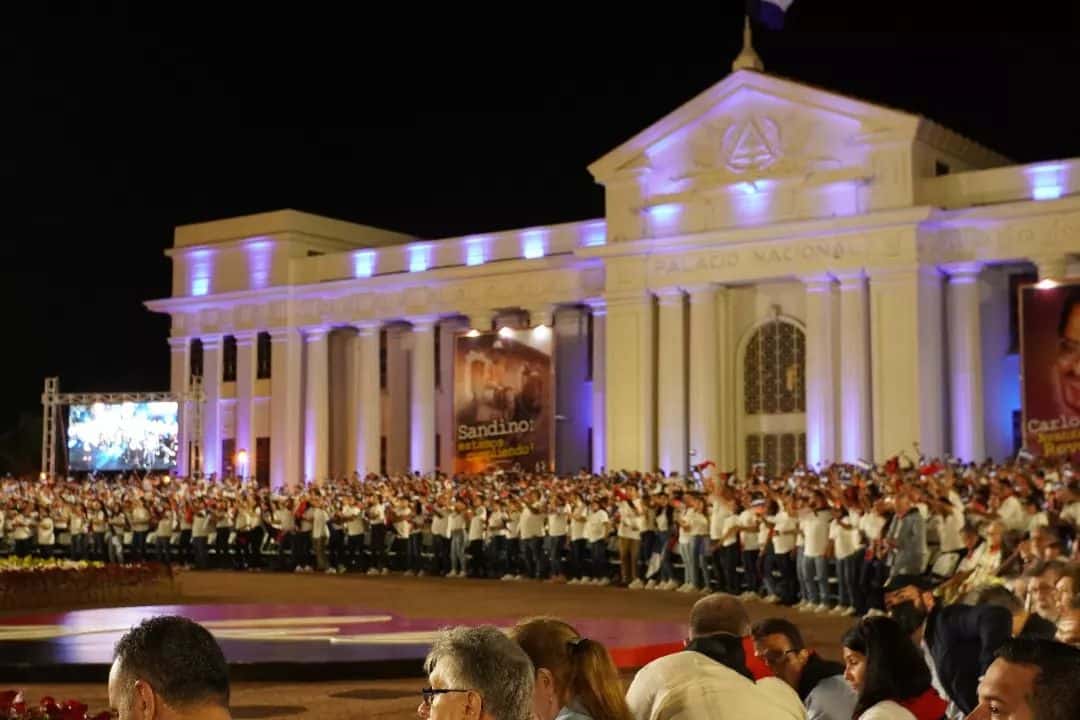
Managua's Plaza de la Revolucion during the celebration of the 43rd anniversary of Sandinista Revolution's triumph. Photo: instagram/@friendsact.

Orinoco Tribune – News and opinion pieces about Venezuela and beyond
From Venezuela and made by Venezuelan Chavistas

Managua's Plaza de la Revolucion during the celebration of the 43rd anniversary of Sandinista Revolution's triumph. Photo: instagram/@friendsact.
Managua, July 20, 2022 (OrinocoTribune.com)—The front-row seat reservations at the central act of the 43rd anniversary of the Sandinista revolution in Managua, Nicaragua, saw no sign of the international community—a stale euphemism for the US’ withering clientele.
Instead, the pantheon of the vaunted multipolar world order took its place: Russia, China, Iran, Venezuela, Cuba, and Bolivia were all represented, as were an assortment of lesser deities, enclaves of resistance, and potential allies: Argentina, Brazil, Angola, Western Sahara, and Palestine, just to mention a few.
The crowd, mostly party youth sprinkled with groups of foreign representatives, danced for an hour to a dozen Sandinista numbers, each performed by a different artist, before the opening speech. This was given by Rosario Murillo, President Ortega’s compañera and vice president, still eloquent at 79 years of age; their co-leadership is a subtle slap in the face to US rituals of liberal democracy.
RELATED CONTENT: ALBA-TCP Criticizes New US Sanctions Against Nicaragua
Following an intermission of more live music, dancing and chanting, Ralph Gonsalves, prime minister of Saint Vincent and the Grenadines, was awarded the Augusto C. Sandino Order. In his speech, full of regal pauses, he rejoiced over how the Summit of the Americas had backfired on the US, citing his “good manners” as the reason for his refusal to attend or to send a delegate in his place.
The 75-year-old went on to praise the Sandinista National Liberation Front (FSLN) for winning the support of the Afro-Caribbean peoples, noting that the Garífuna originally reached Nicaragua by crossing the Caribbean from Saint Vincent and the Grenadines. After establishing this shared history and touching on the collective experience of struggling against US imperialism, El Tio Ralph [Uncle Ralph], as Murillo calls him, posed the question of dialogue with the US, appealing to the US “to reach out in friendship with the government and people of Nicaragua.”
Next came President Daniel Ortega, who began by nonchalantly noting the time—a humorous respite to Tio Ralph’s deliberate and courtly style. Like Ralph’s, his words were devoid of the robot-teleprompter glitches and senile public-relations instructions of the Biden era; nor did he indulge in the typical self-justifying speeches of US career politicians—the 76-year-old felt no need to touch on his accomplishments or his commitment to the people.
Instead, he improvised an organic rebuttal to Ralph’s emphasis on the possibility of dialogue with the Empire. Using Hiroshima as an example, El Comandante Ortega commented on how the US people are rarely consulted prior to the barbarism of their leaders, and noted the perversity of an establishment which nicknamed its atomic bomb “The Little Boy.”
RELATED CONTENT: How Close Are Nicaragua and China to Signing a Free Trade Agreement?
On the stage with him was Brian Willson, who lost his legs in 1987 after being run over by a train in an attempt to stop the arrival of weapons to the Contras. “I’m sure there are thousands of North Americans like him who have good souls” commented Ortega, “who aren’t sons of devils like the ones who only live attacking our peoples.”
Ortega then pivoted to a historical analysis of Nicaragua, weighing the results of previous attempts of dialogue with the US. Each sentence was permeated with the antagonism between the US project and his nation’s sovereignty. He passed from José Santos Zelaya’s failed diplomacy with the US to Augusto César Sandino, who was killed as he left the Presidential Palace after an attempt to negotiate with the US-backed regime in 1934.
He then mentioned how the Somoza regime tried to erase his legacy by destroying Sandino’s remains, which have yet to be found. In a reference to a number performed just before his speech, Ortega said: “Like the song ‘La Tumba Del Guerrillero’ [the tomb of the guerrilla fighter] goes, ‘where, where, where is it?’” and went on to declare that “they could never have imagined that Sandino was already imprinted in the Nicaraguan people.”
As if to conclude his analysis of US-Nicaragua diplomacy, Ortega addressed Tio Ralph directly: “with this dear brother, I’ll tell you why there is no dialogue. Dialogue is impossible, it’s impossible. Dialogue is just for putting the noose around your own neck.”
Special for Orinoco Tribune by Kahlil Wall-Johnson in Managua
OT/KWJ/JRE/SC/SL
